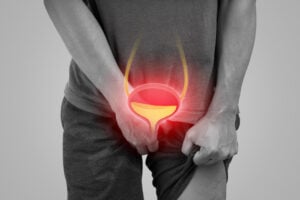Curious about the normal size of the prostate and how it changes with age? Our prostate gland size chart has the answers. This article covers typical prostate dimensions, their evolution over time, and what changes might indicate.
Key Takeaways
- A healthy prostate typically measures about 4 cm in width and weighs 20-25 grams, but size can vary with age.
- Prostate growth is common after age 40, with many men experiencing benign prostatic hyperplasia (BPH) as they get older.
- Treatment for BPH ranges from lifestyle changes to medications and surgical procedures, depending on the severity of symptoms.
Prostate Anatomy
The prostate gland is a small, walnut-sized organ located in front of the rectum and just below the bladder. It surrounds the urethra, the tube through which urine flows out of the body. This strategic location is crucial because any changes in the size of the prostate can directly affect urinary functions.
One of the primary roles of the prostate gland is to produce seminal fluid, which nourishes and transports sperm during ejaculation. This fluid is a vital component of semen, contributing to male fertility. The prostate is divided into several anatomical zones, each with distinct functions. These include the non-glandular stroma, peripheral zone, central zone, and transition zone.
What is the Normal Size of the Prostate?
A healthy adult prostate typically measures about 4 cm in width, 3 cm in height, and 2 cm in thickness. This translates to a weight of approximately 20 to 25 grams, which is what a healthy adult prostate weighs. For a better visual, the average prostate size is often compared to a walnut or chestnut.
The total prostate volume for a healthy adult is generally around 20-25 cubic centimeters. This size is considered normal and indicates a well-functioning prostate gland. However, it’s important to note that these measurements can vary slightly among individuals.
Age-related Changes in Prostate Size
As men age, the prostate gland continues to grow. This growth is particularly noticeable after the age of 40. For instance, the prostate volume increases from approximately 28.17 ml in men aged 40-49 to about 35.03 ml in those aged 60-70. This gradual enlargement is a normal part of aging.
Interestingly, the length of the prostate tends to increase more rapidly than its height and width, especially after 60, significantly contributing to its overall enlargement. Particularly, the transition zone volume grows faster compared to the total prostate volume as men age, especially in the transition zones.
Predictive models suggest that prostate size can increase by 2.0% to 13.6% as men age. Here’s a detailed prostate size chart to illustrate these variations more clearly.
Prostate Size Chart
To understand how prostate size changes with age, consider this detailed prostate size chart. On average, a healthy prostate gland starts at around 5.5 ml in men aged 40-49 and increases to 11.1 ml by the time they reach 70-80 years.
In terms of dimensions, the average prostate width is about 44.45 mm for men aged 40-49, increasing to 46.69 mm for those aged 60-70. Similarly, the height of the prostate rises from approximately 31.66 mm in men aged 40-49 to about 33.50 mm in the 60-70 age group.
These changes in dimensions highlight the expected variations in prostate size over the decades. These norms can help gauge whether your prostate size falls within the average range for your age group.
Enlarged Prostate: Benign Prostatic Hyperplasia (BPH)
Benign Prostatic Hyperplasia (BPH) is a common condition where the prostate gland enlarges but is not related to cancer. Nearly all men experience some degree of prostate enlargement as they age, with about 50% showing early signs of benign prostate hyperplasia by the age of 60 and nearly 90% by the age of 85. BPH affects nearly all men as they age.
Hormonal changes, particularly involving testosterone and estrogen, are believed to be a major cause of prostate growth cell growth. As the prostate enlarges, it can squeeze the urethra, leading to urinary challenges and increased pressure on the bladder.
Symptoms related to emptying the bladder may arise from an enlarged prostate, including increased frequency of urination. If left untreated, BPH can lead to complications such as urinary tract infections and bladder stones.
Symptoms of an Enlarged Prostate
Common symptoms of BPH include difficulty urinating, an urgent or frequent need to urinate, particularly at night, and a weak urinary stream that may intermittently stop. These symptoms can significantly impact daily life, causing discomfort and inconvenience.
Another typical symptom is the inability to completely empty the bladder, which can lead to dribbling at the end of urination. Less common symptoms may include urinary tract infections and the presence of blood in the urine.
Diagnostic Imaging for Prostate Size
Diagnostic imaging is crucial for assessing prostate size. Transrectal ultrasound (TRUS) and magnetic resonance imaging (MRI) commonly estimate prostate volume, with prostate imaging generally considered more accurate.
The prolate ellipsoid formula is used in both TRUS and MRI to calculate prostate volume. However, the ellipsoid formula can face challenges in accurately estimating prostate volume, particularly in non-uniform prostate shapes.
MRI tends to have higher interclass correlation coefficients, suggesting better agreement with pathological specimen volumes. Despite some inconsistencies, these imaging techniques remain essential for diagnosing and managing prostate conditions.
Treatment Options for Enlarged Prostates
Treating BPH offers various options. Lifestyle changes like reducing alcohol and caffeine intake can decrease bladder irritation and urinary frequency. Limiting fluid intake in the evening can also help minimize nighttime bathroom trips.
Common medications include alpha blockers, which help relax the muscles of the prostate and bladder neck to ease urinary flow. Surgical options, such as transurethral microwave thermotherapy (TUMT) and prostatectomy, are available for more severe cases.
Lifestyle Changes to Manage Mild Symptoms
Lifestyle changes can offer significant relief for those with mild BPH symptoms. Regular physical activity like walking or swimming for at least 30 minutes daily can alleviate symptoms. A balanced diet rich in fruits, vegetables, whole grains, and lean proteins improves prostate health and reduces inflammation.
Stress management techniques like meditation or deep breathing also help alleviate symptoms related to an enlarged prostate. Kegel exercises, which strengthen pelvic floor muscles, can improve bladder control and help reduce urinary symptoms.
Surgical Procedures for Severe Cases
When medications are not sufficient to alleviate symptoms, surgical options, including prostate surgery, may be considered. Transurethral resection of the prostate (TURP) is a common procedure that effectively removes obstructive prostate tissue. The procedure typically lasts around 60 to 90 minutes and involves using a resectoscope to remove excess prostate tissue and improve urinary flow.
Post-TURP, patients usually stay in the hospital for one to two days to monitor recovery. While TURP can lead to long-term effects like dry orgasm, it remains a highly effective treatment for severe BPH. Other minimally invasive options, such as laser therapy and prostate artery embolization, are also available.
Summary
Whether through lifestyle changes, medications, or surgical procedures, there are various ways to address prostate enlargement. Stay proactive, consult healthcare providers, and make informed decisions to maintain your prostate health. Remember, knowledge is power, and taking charge of your health starts with understanding.
Frequently Asked Questions
What is the normal size of the prostate?
A normal prostate is usually around 4 cm wide, 3 cm tall, and 2 cm thick, weighing about 20 to 25 grams. So, it’s pretty small but can vary a bit from person to person!
How does prostate size change with age?
Your prostate size typically increases as you age, especially after 40, growing from around 28 ml in your 40s to about 35 ml by your 60s and 70s. So yeah, it’s pretty common for guys to notice that change!
What are the common symptoms of an enlarged prostate?
If you’re dealing with an enlarged prostate, you might notice constant urgency to pee, especially at night, a weak stream, and trouble emptying your bladder completely. It’s definitely something to keep an eye on!
What are the primary medications for treating BPH?
Alpha blockers like tamsulosin and doxazosin are your go-to meds for treating BPH since they help relax the muscles around the bladder and prostate, making it easier to pee.
What are the surgical options for severe BPH cases?
For severe BPH cases, surgical options like TURP, laser therapy, and prostate artery embolization can really help by removing extra prostate tissue to ease urinary flow. It’s all about finding the right fit for your needs!





